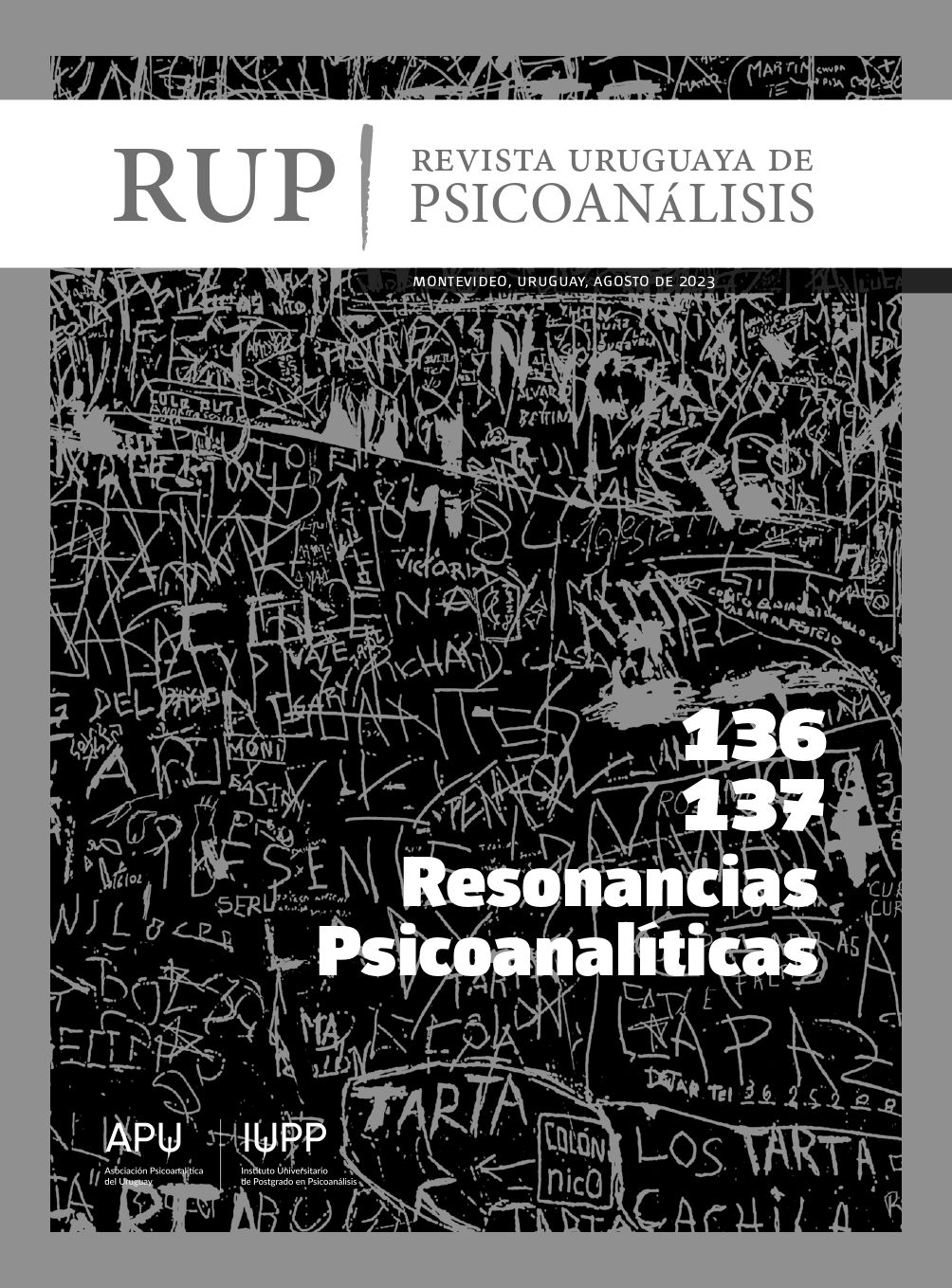Presencia paterna en un mundo cambiante
DOI:
https://doi.org/10.36496/n136-137.a1Palabras clave:
Función paterna, Cuerpo erógeno, Prohibición del incesto, Cultura, Material clínico, PaternidadResumen
En los últimos más de cincuenta años, ha habido un cambio significativo en la comprensión de la posición del padre y su sentido en el desarrollo del niño. Mientras que, previamente, el padre era visto más como una persona distante y, en términos de la concepción freudiana de la constelación edípica, como un mediador de las prohibiciones edípicas para establecer el orden simbólico, un giro cultural ha llevado a nuevas constelaciones familiares y a nuevas concepciones de la posición del padre. Este trabajo se propone comparar y relacionar las recientes perspectivas psicoanalítica y de la psicología evolutiva sobre la importancia del padre con el concepto clásico del Edipo. Basado en la función básica del padre de proteger al hijo/a [child], el trabajo distingue la protección paterna de nivel preedípico de la de nivel edípico. Ambas se complementan mutuamente y, de acuerdo con el autor, en una«posición antiincestuosa» del padre. Esta tesis es ilustrada a través de un ejemplo clínico.
Descargas
Referencias
Abelin, E. L. (1971). The role of the father in the separation-individuation process. En J. B.McDevitt y C. F. Settlage (ed.), eparationindividuation (pp. 229-252). International Universities Press.
Abelin, E. L. (1975). Some further observation and comments on the earliest role of the father. International Journal of Psycho-Analysis, 56, 293-302.
Blass, H. (2011). Der Vater als vertrauter Fremder. AKJP, 151(3), 369-388.
Blos, P. (1985). Son and father: Before and beyond the Oedipus complex. Free Press.
Brehm, U., Huebener, M. y Schmitzet, S. (14 de diciembre de 2022). 5 Jahre Elterngeld. https://www.bib.bund.de/Publikation/2022/pdf/
-Jahre-Elterngeld-Erfolgeaber-noch-Handlungsbedarf.pdf?__blob=publicationFile&v=2
Dammasch, F. (2008). Die Krise der Jungen:Statistische, sozialpsychologische und psychoanalytische Aspekte (pp. 9-28). En F. Dammasch (ed.), Jungen in der Krise: Das schwache Geschlecht? Psychoanalytische Überlegungen. Brandes & Apsel.
Dammasch, F. (2009). Der Junge ohne vaterliche Struktur. En R. Haubl, F. Dammaschy H. Krebs (ed.), Riskante Kindheit: Psychoanalyse und Bildungsprozesse. Göttingen (pp. 49-66).
Vandenhoek & Ruprecht. Diamond, M. J. (1997). Boys to men: The maturing of masculine gender identity through paternal watchful protectivness. Gender and Psychoanalysis, 2, 443-468.
Freud, S. (1999). Totem and taboo. En J. Strachey (ed.), The standard edition of the complete psychological works of Sigmund Freud (vol. 13).Vintage. (Trabajo original publicado en 1913 [1912-1913]).
Freud, S. (2001). Civilization and its discontents. En J. Strachey (ed.), The standard edition of the complete psychological works of Sigmund Freud (vol. 21). Vintage. (Trabajo original publicado en 1930 [1929]).
Gaschke, S. (4 de octubre de 2015). Die Generation der Supervater. Welt am Sonntag, 4(40), 2-3.
Green, A. (2009). The construction of the lost father.En L. J. Kalinich y S. W. Taylor (ed.), The dead father: A psychoanalytic inquiry (pp. 23-46).Routledge.
Harris, A. (2009). Fathers and daughters. En B. Reis y R. Grossmark (ed.), Heterosexual masculinities: Contemporary perspectives from psychoanalytic gender theory (pp. 189-215). Routledge.
Herzog, J. M. (1994). Patterns of expectant fatherhood: A study of the fathers of a group of premature infants. En S. H. Cath, A. R. Gurwitt y J. M. Ross (ed.), Father and child. Routledge.
Kaddor, L. (2015). Zum Töten bereit: Warum deutsche Jugendliche in den Dschihad ziehen. Piper.
Klein, M. (1998). Gesammelte Schriften (vol 2.). Frommann-holzboog. (Trabajo original publicado en 1932).
Lacan, J. (1966). Funktion und Feld des Sprechens und der Sprache in der Psychoanalyse. En J. Lacan, Schriften 1 (pp. 71-169). Walter-Verlag. (Trabajo original publicado en 1953).
Laplanche, J. (2011). Nouveaux fondements pour la psychanalyse. PUF. (Trabajo original publicado en 1987).
Loewald, H. W. (1960). On the therapeutic action of psycho-analysis. International Journal of Psychoanalysis, 41, 16-33.
Meltzer, D. y Harris Williams, M. (2008). The apprehension of beauty: The role of aesthetic conflict in development, art, and violence. Karnac.(Trabajo original publicado en 1988).
Metzger, H.-G. (2006). Das Erlebnis der Vaterschaft und die Angst vor der frühen Kindheit. En F. Dammasch y H.-G. Metzger (ed.), Die Bedeutung des Vaters (pp. 313-332). Brandes & Apsel.
Metzger, H.-G. (2013). Fragmentierte Vaterschaften: Über die Liebe und die Aggression der Vater.Brandes & Apsel.
Ogden, T. (1989). The primitive edge of experience. Jason Aronson.
Rotmann, M. (1978). Über die Bedeutung des Vaters in der «Wiederannäherungsphase». Psyche, 32, 1105-1147.
Schirra, B. (2015). ISIS: Der globale Dschihad. Econ.
Seiffge-Krenke, I. (2001). Väter und Söhne, Vater und Töchter. Forum Psychoanal, 17, 51- 63.
Thomä, D. (2008). Vater: Eine moderne Heldengeschichte. Hanser.
Tönnies, S. (30 de agosto de 2009). Männer zu Vatern.
Frankfurter Allgemeine Sonntagszeitung, 35, 11.
Winnicott, D. W. (1984). Kind, Familie und Umwelt. Reinhardt. (Trabajo original publicado en 1964).
Descargas
Publicado
Número
Sección
Licencia
Derechos de autor 2023 Revista Uruguaya de Psicoanálisis

Esta obra está bajo una licencia internacional Creative Commons Atribución 4.0.


 This work is licensed under a
This work is licensed under a 